Billy Cummock.
13383042
Framing Statement:
Shelve-d was a performance created to be presented within the Free Zone of the Great Central Warehouse Library on the University of Lincoln grounds. It was an analysis and exploration of the history of the Great Central Warehouse and its inner workings as a library. We set out to explore the definition of a library and what it would be like to invade the space with different types of work, such as for example, building shelves. This motif was used as a way of exploring the culture of a library and how it stands as its own society with its own laws as such.
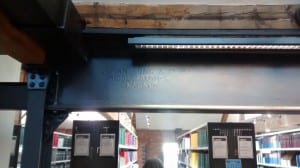
It was clear after little research that the library had in fact lived more than one life, coming to prominence as a railway goods warehouse as well as spending the second half of the 20th century as a builder’s merchant before falling into disrepair in 1998. Our group decided that the exploration of the rules of the library as well as mirroring that against its history was of great interest and we felt that we needed to take it on for our project.
We decided to build shelves in the Library’s free zone, whilst in the process we would be sending out a live microphone sound and video feed to participating audience members to allow them to share in the journey with us.
The performance took place on the 8th May 2015, a peak time for potential audience members as we were right in the midst of exam season, and it was a weekend, so we were placed at the peak possible date to be able to have maximum participation. The performance was quickly scheduled to be 8 hours to represent the normal running hours of a working day; unfortunately 9 a.m. – 5 p.m. wasn’t available due to unforeseen circumstances so we decided to go with 11 a.m. -7 p.m. in order to allow our assessors the privilege of seeing our defining piece, having the time frame of 8 hours during a large and busy time during the day would be a great advantage to us because the amount of time going by as to the amount of students working in the library are (usually) directly proportionate, you get me?
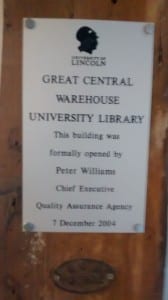
Our target audience consists of mainly university of Lincoln students, those of which primarily use the library as their public domicile when exam season comes around. The audience themselves do not participate in any of the activities themselves but they are a vital part of the performance due to their knowledge of, and presence in, the library.
Analysis of Process:
The purposes of fluidity now request that I start from the beginning in order for you nice folk to be able to get an inkling of just what we did throughout our time studying site specific performance.
Library:
A building or room containing collections of books, periodicals, and sometimes films and recorded music for use or borrowing by the public or the members of an institution: a university library. (oxforddictionaries, 2015)
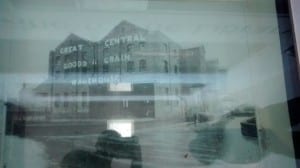
In the beginning, I explored the GCW library in many different ways, collecting documentation of its walls and trying to respond to its architecture were key features present in my mind when starting out the process in which to create a performance that was site specific. As a group, we decided that an exploration of the library’s architecture was a perfect starting point for us to work on our piece; we set out originally to build a scale model of the library (around 3 feet tall) in the silent study room on the 3rd floor. We wanted to explore the rules of a library whilst also breaking the status quo of conventions associated with one; libraries are usually quiet, studious places in which people gather in order to read so that they may educate themselves or lose themselves in a book. We wanted to break the usual convention of having a library as a place where you only study through the reading of books; we wanted to challenge the library by asking a simple question: Why can I not study construction practically?
This produced a working experiment conceived in the group study room on the 3rd floor of the library in which we wanted to see how a working dynamic would affect the 3rd floor environment if we were to suddenly invade it by building a half model of the library using cardboard. Our objective was to be able to invade the space so that our piece ‘somehow activates, or engages with, the narratives of the site’ (Morgan, 1995, cited in Pearson, 2010, 35) so that we could find out as much information about how our piece affects the site we are working in. The hope was that our exercise would draw attention and lead us to have ‘juxtaposed diverse elements to generate interpenetrating and multifocal frictions’ (Pearson & Shanks, 2010, 112) The sad conclusion to this experiment, however interesting it was, is that we were asked to leave for being too loud, I know right? In hindsight, I still don’t know why we had gained complaints, we were really trying to hush down, but alas poor group room, we knew you so well.
Another hurdle we were soon to have to accomplish was the trickiness that was building a scale model of the library in such a small space; was it possible? The room itself was indeed much too small to be able to create such a mammoth of a model and making it even smaller would deteriorate the quality of such a model. However, the biggest hurdle facing us was that not one of us had any real experience in model making, and we didn’t exactly do a great job when it came down to making one out of cardboard, the prospects for a miniature library were slowly, but surely, drawing to a close.
‘Site-specific performances are those conceived for; mounted within and conditioned by the particulars of found spaces: existing social situations or locations, both used and disused’ (Pearson, 2007, cited in Pearson, 2010, 35)
To put this statement into context, our performance would have to be quiet, dead quiet; we wouldn’t be able to even speak on the third floor (as demonstrated) and we would have to try our hardest to dampen any sound we produced if we were to create any sort of site specific performance whilst on the 3rd floor, I started to believe that the possibilities for the group room had slowly started to dwindle. They do however state that every cloud has a silver lining and that little piece of Ag is Sound!
Sound was a defining factor when researching through our performance, we wanted to use sound in order to create a soundtrack to the library you don’t usually hear; the sounds of labour would ring throughout so that the library would be filled with a different background noise. It would still be a soundtrack of study; however it would be the sounds of saws cutting through wood and nails being hammered in. We had decided that we would dampen the sounds of our tools in order to adhere to the rules of the library, the dead silence that rings throughout aside from the turning of pages and the tapping of keyboards. We would create a soundscape that would explore work creating a different perspective on the other parts of the library; our soundtrack would replace the normal cohesive nature of the library. Much like the library is awash with sounds that reflect the hours of studious work that go on in the library, our sound would be used so that it too ‘reflects the manufacture of society; it constitutes the audible waveband of the vibrations and signs that make up society’, (Kelly, 2011, 91) the society here however being the students working in a library.
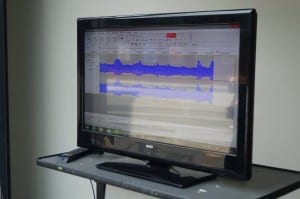
Meanwhile, in a separate dimension I was thinking of a quick and easy alternative to building a model, one that would require little thinking time and have no complicated dimensions. Ideas floated around amongst the group whether or not it would be a good idea to create a chair or a table; however these ideas quickly fell flat because of their individual complexities. Finally, we had decided upon THE MOTHER of all easy designs, the thing that made Ikea what it is today, the shelf! The shelf is ergonomically designed (I use this term loosely) to hold things to a much higher standard than most people, as well as it being an absolute doss (simple) to make. Voila. We had our project.
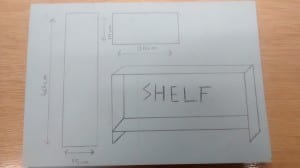
Through the use of the visual workings of the manufacture of a shelf and harnessing the by-product that is the sound created from the vibrations when we work; we were able to ‘enact a spatial history, mediating between the past and the present […] as well as between a sense of nostalgia for the past and a sense of otherness possibly felt in the present and anticipated in the future’, (Harvie, 2005, 42) through the use of sound alongside the visual of building.
Our performance was coming together nicely, the structures we were building were set and the exploration of sound was going to be a huge part of our performance art. However, we were having difficulty reasoning with ourselves about where we could potentially put our performance other than the group study room, ideas were floated around about where we could potentially set up however most didn’t come with a view into the room that was substantial enough, seeing as we couldn’t let any one into the space because of the toxicity of the sawdust that would eventually come off of the medium density fibreboard (MDF). The free zone was the most obvious choice, it had a view from the outside and it was on the ground floor, it was open to all and easy to access, so we chose it. The space was a good example of an area where we could efficiently build whilst still aiming ‘to make political interventions in relation to [our] audiences’ (Allain & Harvie, 2006, 149) as well as with the library.
Moving to the free zone had posted a new obstacle to overcome; how would the audience be able to hear us from within a room that is nearly soundproof to the outside world? I had thought that maybe setting up some speakers outside of the free zone as well as a microphone inside would mean that we would be able to allow the outside to hear us; however we soon discovered that would draw away from our focus of adhering to at least some rules of the library as we would no doubt definitely break the sound rule by playing speakers. So it was set out that we would set up many different microphones inside, 3 to be precise, in order to be fed live through a mixing desk and wirelessly outside to the eager beavers outside. This was inspired by Janet Cardiff’s 40 part motet in which she had recorded the individual voices of a choir and played them back through as many speakers in order to create a sound harmony without visual stimulus. (Wisco, 2013) We would use sound in this way as to create a soundscape from 4 different noises being recorded at the same time, allowing the audience to hear the sounds of work through the headphones in a different light. If they so should choose they could wander off into the library wearing them as to get the auditory experience without a visual aid, allowing the audience to see the library in a completely new light; It would be like discovering the library for the first time through the sounds you hear, a little bit like daredevil if you ask me.
Other problems arose with the muffling of the sound when we discovered that it would nearly impossible to muffle any sound which came from sawing or hammering. The Sanding of wood and varnishing itself was quiet enough to be left alone however we were at a disadvantage with the sound produced from the heavy labour involved in the building of many shelves. This is when we decided to scrap the idea of muffling sound as the free zone itself was quiet enough to produce no sound outside of the room so as to adhere with the rules of the site. The main focus of the performance would be exploring the library’s rich heritage and ‘the extent of [it’s] historical occupancy’ (Pearson, 2010, 104) through our performance as well as the honing of the sound in order to create a different soundscape for the library.
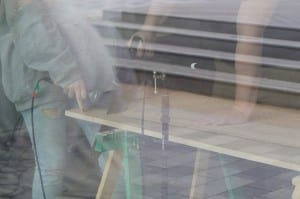
Another influence of ours after was the Spill Festival’s Bone Library in which Sarah Jane Norman took the bones of animals and inscribed ‘dead’ aborigine words into them in order to show the connection between these two dead things, people were allowed to take them out as if they were a book and then bring them back after words as though they were a part of a normal library. (Spill Festival, 2014) We took this as an inspiration for our piece as we wanted to create ourselves a new type of library, the building of the shelves itself are a metaphor as to represent the creating of a library, we were building our own miniature library.
The progression of time was a key feature we decided to use next in our performance as we wanted to have a representation of how much time was going by as we were building our library, the shelves were going to be labelled as to represent the exact amount of time since the beginning of the project it took to create them, a fair representation of the different stages of the life of the Great Central Warehouse, it’s transformations from Railway to Builder’s Merchant to a renovated library, an exploration of the architecture of the building much like that of the Wrapped Reichstag. (Scando, 2010)
Lastly, we decided after our work-in-progress that the collection of the saw dust left over from each shelf would be a good representation of the by-product of every action, much like the sound is a by-product of any action, a collection of vibrations; we were going to use the sawdust as a metaphor for the by-product of labour, the left over remnants of the build as well as a representation of information that isn’t absorbed by that of a student reading a book.
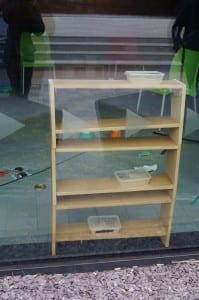
Performance Evaluation:
We got to the site at 11 a.m. ready to set up by laying down tarp on the floor and setting up all of technical side of the performance. When we were ready to begin we saw nearly no audience members for the first 3 hours, apart from a few smoking students that sit outside of the free zone. This had become a destabilising feature of our performance as we were losing hope that anyone would take any interest in the auditory section of our performance.
As time went by and we got into the start of the afternoon, we saw numbers rise in the amount of people taking notice in our performance from students entering and/or hanging around the library. The numbers of people participating with the headphones started to rise as the day went further on until we had a number of responses from many audience members as well as questions on what our performance was about. Most audience members seemed to get the gist of what we were doing as well as some even understanding that our piece was an exploration of the library’s history, architecture and social connotations.
Overall, the visual element of our performance went down like an ice cream truck in the middle of summer; it went down a treat. Audience members reacted really well to our performance; there wasn’t a post on Yik-yak in sight. The overall production line method we used could have used a lot more work as we were struggling to keep things going simultaneously however we resolved this for when our assessor’s came, so as to give them the full experience of what we were doing. The lending of the headphones could have been thought out more thoroughly as we had only one person wander throughout the library wearing the headphones gaining the full experience of the auditory section of our performance, listening in to our artificial soundscape of work.
In order to improve our performance, we could have done more research in to how to muffle the sounds of work we were doing so that we could have gained a better aesthetic experience for the audience members; perhaps using a different range of materials, such as felt, in order to better soundproof the sounds of labour.
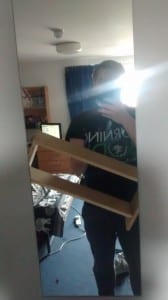
My understanding of site-specific theory has gained ground since the beginning of the module as I have discovered that performing in a specific location is moulded by the history and social connotations of the site itself; the boundaries in which we perform can forever change whilst working with the site, whether it be responded to the site as a whole or the change of context when entering a different room or perhaps a stairwell.
Working with the library has been an enlightening experience in which I have seen the different connotations of every aspect of it, even down the mere definition of the word itself. A library is no longer a place where an archive of books is found and borrowed; it is simply a location in which people gather in order broaden their minds, as well as lose countless amounts of sleep.
The real question however, is what will become of this fine piece of architecture? Will it be born again in a decade’s time? Will it become a representation of life around it? Or will it be swallowed up by the earth around it when all is gone from this place?
(I am philisophibill)
Word Count: 3197
Bibliography:
Allain, P. & Harvie, J. (2006) The Routledge Companion to Theatre and Performance. Abingdon: Routledge.
Etchells, T. (1999) Certain Fragments. London & New York: Routledge.
Harvie, J. (2005) Staging The UK. Manchester & New York: Manchester University Press.
Kelly, C. (ed.) (2011) Sound. Cambridge: MIT Press.
Klich, R. & Scheer, E. (2012) Multimedia Performance. Basingstoke: Palgrave Macmillan.
Oxforddictionaries. (2015) Library. [Online] Available at: http://www.oxforddictionaries.com/definition/english/library [accessed May 12th 2015]
Pearson, M. (2010) Site-Specific Performance. Basingstoke: Palgrave Macmillan.
Pearson, M. & Shanks, M. (2001) Theatre/Archaeology. Abingdon: Routledge.
Scando. (2010) Wrapped Reichstag – quickmotion – Christo and Jeanne-Claude. [Online video] Available from https://www.youtube.com/watch?v=esiErDm62E4 [Accessed on 12th May 2015].
Spill Festival. (2014) Bone Library. [Online video] Available from: http://spillfestival.com/show/bone-library/ [Accessed on 12th May 2015].
Wisco, A. (2013) The 40 Part Motet by Janet Cardiff. [Online Video] Available from: https://www.youtube.com/watch?v=ncWFLzVrwU4 [Accessed on 11th May 2015]